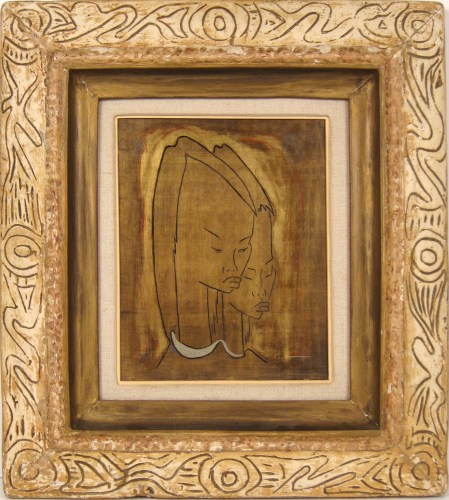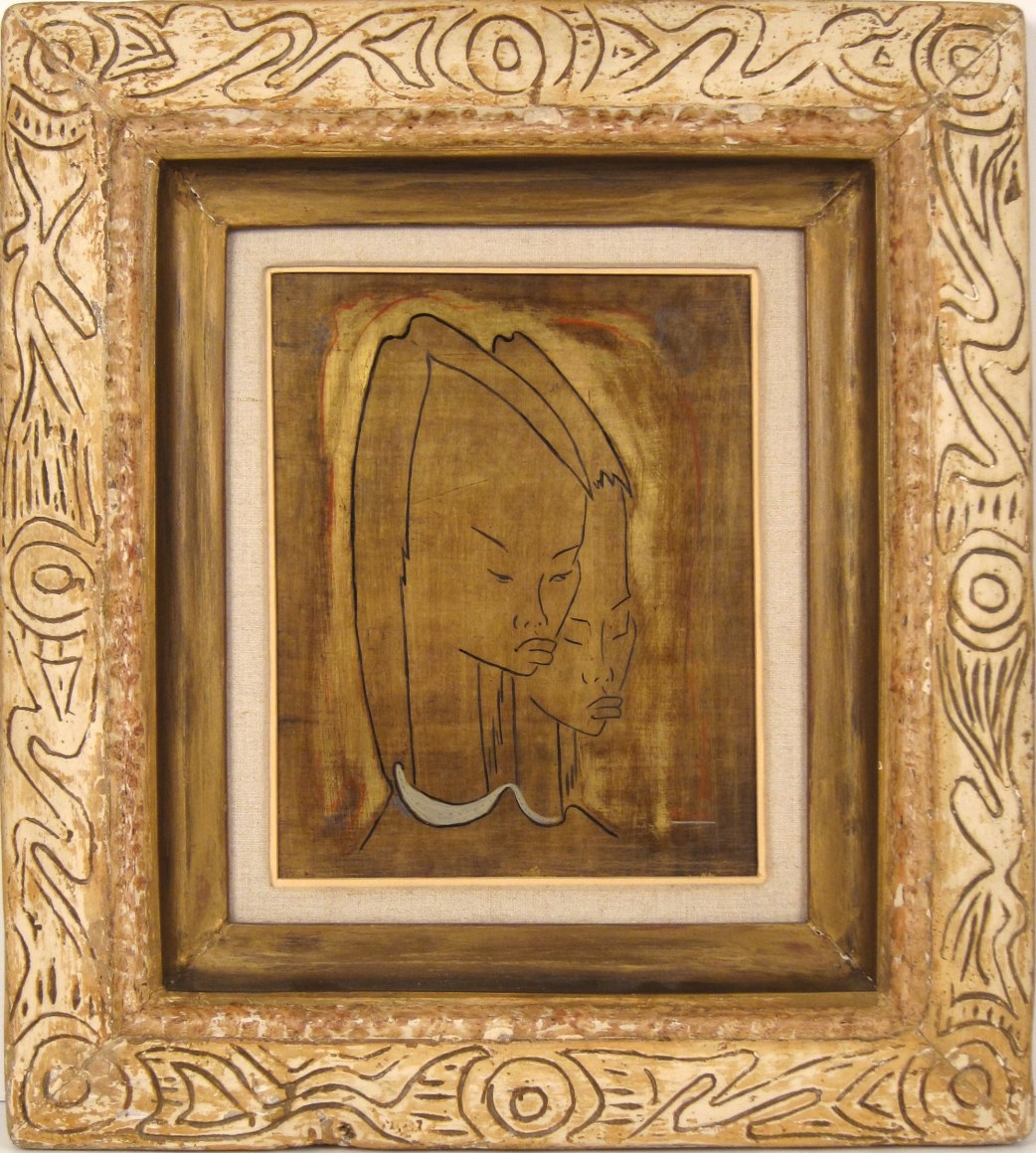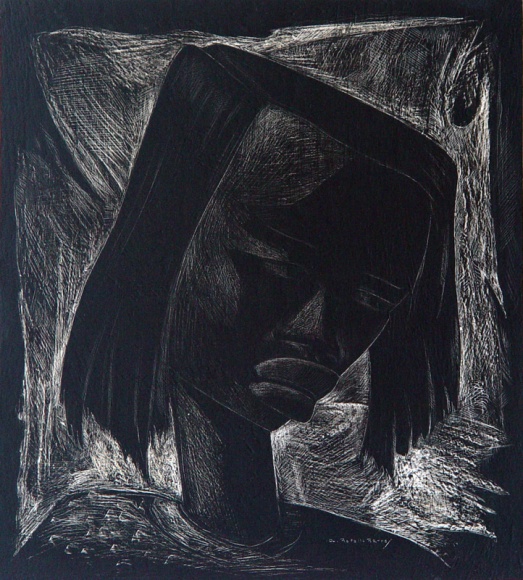Angel Botello

Haitian Girls, circa 1960
Predominantly known for his work in painting and sculpture, Angel Botello was a Spanish – Puerto Rican painter, sculptor and graphic artist. Angel Botello is widely considered one of the greatest Latin American post – modern artists.
Angel Botello was born on June 20, 1913 in Cangas de Morrazo within the Galicia region of northwestern Spain. Angel Botello was the first of six children of Angel Botello Suarez, who was a businessman in the fish canning industry, and Bonis Barros del Amo. During his childhood, Angel Botello enjoyed watching the fishing boats navigate the port of Cangas, but at age five his family moved to the city of Vigo. His father died shortly after the family moved and Angel Botello attended school in Vigo until he was 13 years old. After the bankruptcy of the family business in the 1920s, Angel Botello moved to Bordeaux, France with his mother, brother and four sisters in hopes of escaping the economic depression in Spain.
His mother wanted Angel Botello to be a farmer, so he attended the Ecole d’Agriculture for two years where he sought to become to an agronomist. At the same time his brother Manuel studied at the Ecole d’Architecture and attended a few classes at the Ecole des Beaux-Arts of Bordeaux. Inspired by the artwork his brother produced, Angel Botello gave up agriculture because he wanted to be an architect. In 1930-1934, Angel Botello studied at the Ecole des Beaux-Arts, where he was a special student of the Rome prized artist, professor Roganeau. Architecture is considered a beau art rather than a science in France, so Angel Botello was required to take art courses in pursuit of his goal of becoming an architect. Angel Botello and and his younger brother Manuel were top students in each of their classes. Both graduated with honors and excelled in drawing, painting and modeling. In 1933-1934, Angel Botello had his first exhibitions at the Societe des Amis des Arts in the small town of Perigeux near Bordeaux.
In the years leading up to the Spanish Civil War, with the perpetual political tension in the country, the Republican government favored and propagated all forms of contests, exhibitions, or activities tied to the development of the arts or culture. This is evident through the policies and events surrounding this time, such as the Constitution for the Expansion of Study, which gave artists and intellectuals greater opportunities to travel and study throughout Europe, or the creation of the National Committee for the Conservation of Artistic Treasures in 1936. This had great repercussions on the artistic development of Angel Botello. In 1935, the artist was granted a scholarship to study at the Real Academia de Bellas Artes de San Fernando in Madrid, Spain under the Count of Cartagena Fellowship and then another by the Delegation of Pontevedra. During this period back in Spain, Angel Botello revisited his childhood home and painted many of his countries landscapes. That same year, Angel Botello was also able to exhibit his work at the cultural institute at Vigo in Galicia, and again in 1936 as one of the 500 artists who participated in the National Exhibition of Fine Arts in Madrid. The paintings of Angel Botello from this period reflect the break of the artist from his strictly academic training to the impressionist and post impressionist concepts and techniques that shaped his development.
Featured works
Biography
Angel Botello planned to continue his studies in Spain, but was was forced to interrupt them with the outbreak of the Spanish Civil War on July 18, 1936. Angel Botello served under General Enrique Lister, who was founder of the Spanish Communist Worker’s Party (PCOE), after enlisting in his platoon as a cartographer. He and his brother Manuel joined the Republican Army, but the Nationalists ended up winning and his brother died on the war field. In 1939, the Spanish Civil War ended with the victory of General Francisco Franco and the fascists. After the war ended, Angel Botello found it impossible to stay in Spain after fighting for the losing side and he had to flee persecution. The artist returned to France to find his family living in a refugee camp. In France, the Botello family stayed in a refugee camp for some time, but were soon attempting escape to Mexico under the funding of the Spanish Republican Government.
Shortly afterwards Angel Botello and his family boarded the french ship La Salle en route to Santo Domingo in the Dominican Republic. After many detours of these ships, the Botello family finally reached Santo Domingo. Like many other members of the Spanish intelligentsia and artist community, Angel Botello and his family were looking to begin a new life in exile for supporting the libertarian ideas and democratic system the new dictatorship did not tolerate. In Santo Domingo, Angel Botello met a group of artists exiled from Spain and he benefited greatly from their companionship. Shortly after his arrival Angel Botello was given commissions by a government office and a daily newspaper. These projects earned the artist enough money to organize a solo show of his work, where his paintings were very well received and resulted in a commercial success. Angel Botello was quickly welcomed and accepted by the artistic community, finding immediate recognition. Several of the paintings created by Angel Botello in the Dominican Republic were included in the Latin American Art Exposition organized by Henry Wallace, who would later become Vice President of the United States. In 1940, the exposition at the Riverside Museum was one of the activities of the New York Fair.
In the same year, Angel Botello spent eight months in Cuba, where by 1943 the painter had earned his lifelong nickname of “The Caribbean Gauguin” for his use of bold colors and depictions of island life. It was coined by Jose Gomez-Sicre who was a famous Cuban art critic and an advisor to Alfred Hamilton Barr, Jr., who was the first director of The Museum of Modern Art. The nickname first appeared in a mention by Jose Gomez-Sicre in a Havana newspaper for the similarities of techniques and shared sensitivities between Angel Botello and the french post-impressionist and symbolist artist Paul Gauguin. Along with Picasso and other artists of the period, particularly those in Spanish exile, the drawings and paintings of Angel Botello reflect the search for new means of expression found in the principal artistic movements of the first half of the century from post impressionism to fauvism.
Between 1940-1943, Angel Botello would travel extensively throughout the the Caribbean where he lived on several different islands. He visited Haiti, Puerto Rico and Cuba where he painted and held several more solo shows of his work that led him to greater success. Upon his return to Santo Domingo, the paintings of Angel Botello were admired by the Peruvian ambassador, who invited the painter to exhibit in Port-au-Prince, Haiti in 1944. This island made a special impression on Angel Botello and he was immediately fascinated by the tropical scenery. On July 9, 1944, Angel Botello returned to Haiti under an invite to paint the president and his family. During this trip, Angel Botello met and married his wife Christiane Auguste on January 24, 1945. After his marriage to Christiane, Angel Botello changed his artistic plans to move to Mexico to meet with Diego Rivera, who was widely considered to be the greatest Mexican artist, and stayed in Haiti.
Angel Botello designed and built a home for his new wife in Petionville. In his new surroundings, Angel Botello would spend the next ten years painting the women of Haiti where he became increasingly recognized and critically acclaimed. For more than a decade his art work was influenced by the colors and energy of Haitian life. The Haitian landscapes of Angel Botello were painted with his characteristic awareness of design in the pure, bright colors of the tropics. The Haitian landscapes and figure studies of Angel Botello are considered to be some of the best works of the artist. Also, he developed his woodworking talent while in Haiti. As a result, Angel Botello is considered to be the father of Haitian wood carving and taught Haitian artists his techniques.
In 1953, Angel Botello moved to San Juan, Puerto Rico where the artist would live and work for the rest of his life. By this time, he already had gained international recognition in the world of plastic arts. Angel Botello became a pioneer of the local art scene in Puerto Rico by opening one of the first art galleries on the island. He and his family opened their first gallery at the Caribe Hilton Hotel, followed by several other galleries over the years in the Metropolitan area of San Juan, Puerto Rico. Although his main subject changed over the years, Angel Botello continued to paint Haitian women after his arrival in Puerto Rico. Angel Botello is often quoted saying that the tropics opened a new world for him, stimulating his creativity with its bright colors. The myriad facets of what sometimes appears to be the same being are a constant in the work of Angel Botello throughout his career. Other constants in the paintings of Angel Botello include: nudes in richly ornamental settings reminiscent of Matisse; heads joined rhythmically in non-representational compositions; semi-schematic figures seen against landscape, where figures are pared down to elements of a larger design.
In 1959, Angel Botello spent time in Ravena, Italy to learn about the mosaic technique. The artist produced some of them, but quickly abandoned this technique because he was convinced that he had mastered it. In the 1960s, Angel Botello became interested in printmaking techniques after an art dealer reproduced some of his paintings. The artist refused to sign these prints because he never personally worked on or was consulted on their production. This lead Angel Botello to travel to Paris, France to learn about printmaking techniques. As a result, Angel Botello became a master in printmaking techniques and graphic design. The best known printmaking works of Angel Botello are his linocuts, lithographs and serigraphs.
Angel Botello and his wife adopted three children Manuel, Juan, and Francoise, who were born in 1959, 1960 and 1962 respectively. His wife and children would play an important role throughout the rest of his career. It has been suggested that the recurrence of the female motif in the paintings of Angel Botello reflects the strong mother, loving wife and daughter which were the emotional underpinnings of his life. While masculine figures rarely appear in the work of Angel Botello, his two sons as well as his daughter inspired many of his paintings and sculpture after the late 50′s. Particularly in the 1960s, the work of Angel Botello is known to be very personal with many references to his wife and children in his paintings and sculpture.
While Angel Botello maintained his permanent residence with his family in San Juan, Puerto Rico, the artist continued to travel often during these years. His most frequent destinations were trips to New York and France for work. During this period, Angel Botello set up several studios and he spent a lot of time searching for his ideal studio. The artist wanted a studio that was large and comfortable to house all of his work. Eventually, Angel Botello found a large, but not so comfortable one on Calle Sol and worked there for ten years until a fire burned and flooded it in 1979. Then, Angel Botello found a new building he could turn into his ideal studio on Calle Norzagaray. This new location provided beautiful views of the Atlantic Ocean and the city of San Juan.
In the early 1980s, Angel Botello started a double artistic career in painting and sculpture. In 1985, Angel Botello was diagnosed with lung cancer after being a heavy smoker for his entire life. Recognizing that his health was jeopardizing his life and work, the artist poured his energy into his artistic expression. In that final year, Angel Botello created an incredible 22 sculpture, which is an astonishing achievement for an artist who refused to use any artist assistants.
The 33 year period Angel Botello spent living in Puerto Rico is widely considered to be the most prolific years of his life. Both the quality and quantity of his paintings and sculpture are noteworthy. The work of Angel Botello during this period demonstrates a strong figurative and surrealism influence which has garnered the most recognition for the artist. In Puerto Rico, this period is known as the “Botellian Style” and is recognized by his caricature figures especially of girls. The sculpture subjects of Angel Botello were often his beloved children and the simple beauty and expressions in them communicate a wonderful innocence and grace.
Angel Botello never attached to any particular artistic school or movement and was a protean artist in that he developed his own artistic style. During his life, Angel Botello was a versatile and many-sided artist who worked in all artistic mediums at his reach and left behind an impressive legacy of oil paintings, drawings, printmaking, lithographs, linocuts, serigraphs, bronze sculptures, wood carving, photography and mosaics.
Angel Botello died on November 11, 1986 in San Juan, Puerto Rico. Today, the Galeria Botello on Cristo Street in the colonial Old San Juan, exists in the former private residence of Angel Botello. The gallery is run by his son Juan and continues to serve as a tribute to the legacy of the sculptor and painter featuring many of the paintings, sculpture and drawings created throughout the life of the artist.
Sources include:
Angel Botello en la historia del exilio Gallego, Matilde Albert Robatto, Edicios Do Casto, La Coruna, Spain, 1995
Botello: Angel Botello Barros, Galeria Botello, San Juan, Puerto Rico, 1988
The essay herein is the property of SPELLMAN GALLERY and is copyrighted by SPELLMAN GALLERY, and may not be reproduced in whole or in part without written permission from SPELLMAN GALLERY, nor shown or communicated to anyone without due credit being given to SPELLMAN GALLERY.



